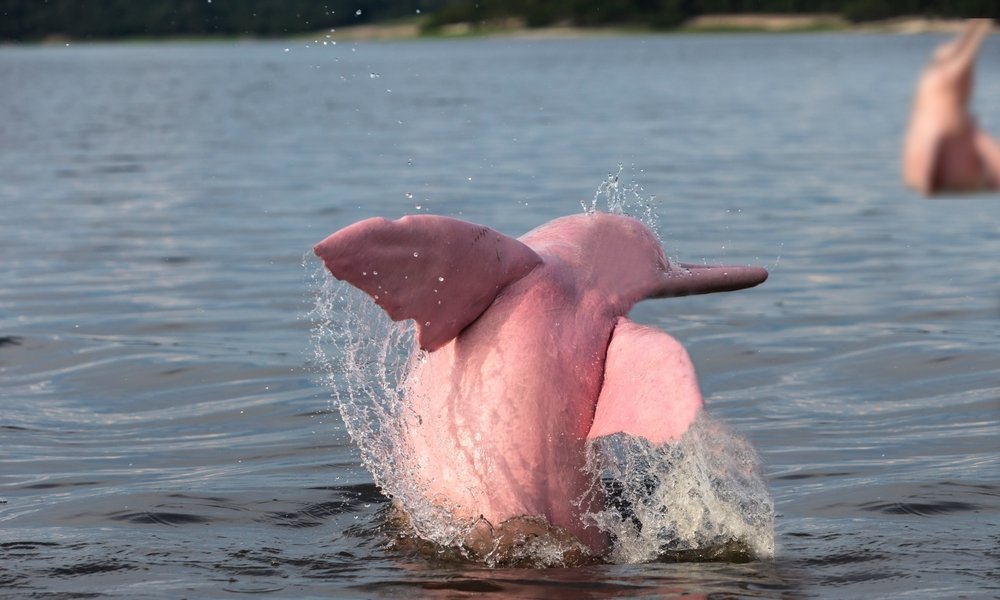Have you ever wondered How Many Pink Dolphins Are Left In World? It is a common freshwater cetacean that is thought to have a number in the tens of thousands.
In some places, though, it is considered vulnerable because of dams that separate and risk some populations, as well as other threats like pollution in rivers and lakes.
Table of Contents
Ecology and physical appearance
Pink dolphins, also known as Amazon river dolphins or Boto dolphins, are a captivating species that inhabit the rivers of South America. Some populations of Pink Dolphins have adapted to living in slightly salty waters, which has allowed them to expand their range and thrive in different environments.
Their unique pink coloration and intelligent nature have made them a beloved symbol of aquatic biodiversity. The vertebrae in pink river dolphins’ heads are not fused together like they are in other dolphins, which makes them very agile.
Because they can turn their heads 90 degrees, they can get around tree branches, rocks, and other things that might get in their way. However, their population has been steadily declining, raising concerns among environmental activists and animal lovers alike.

The behavior of Pink Dolphin
Pink dolphins are usually seen alone or in pairs, but they can also be seen in groups of no more than eight. In the Amazon, pods with as many as 37 people have been seen, but three is the norm.
Up to 35 pink dolphins work together to catch their food during prey time. Usually, social bonds form between a mother and her child, but they can also form between people of different backgrounds or between bachelors.
The biggest groups can be found in places with lots of food and at the ends of rivers. A lot of separation happens during the rainy season. Males live in the river channels, while females and their young live in places that are flooded. It’s not like that during the dry season, though.
Large sections directly affected by whitewater (like major rivers and lakes, especially during low water season) have bigger group sizes than smaller sections directly affected by blackwater (like channels and smaller tributaries).
This is because there are more prey fish in the larger sections. In freshwater, where they live, they are the top predators, and their groups rely more on food sources and the availability of habitat than on oceanic dolphins, who need to be protected from bigger predators.
How Many Pink Dolphins Are Left In World? Causes for the Decline in Population

The decline in pink dolphin population is primarily attributed to human activities and environmental factors. Habitat loss, pollution, and climate change have significantly impacted their numbers.
Human-driven activities such as fishing practices, dam construction, and deforestation have disrupted their natural habitats, making it more challenging for pink dolphins to thrive.
Role of Pink Dolphins in the Ecosystem
Pink dolphins play a crucial role in the delicate balance of aquatic ecosystems. As indicator species, their presence or absence can indicate the overall health of their habitat. They help maintain ecological stability by regulating fish populations and acting as seed dispersers for aquatic plants. Preserving their population ensures the conservation of their unique habitat and the myriad of species that depend on it.
Current Conservation Efforts

Fortunately, there are numerous ongoing conservation efforts dedicated to protecting pink dolphins. International organizations, local initiatives, and research and monitoring programs work tirelessly to raise awareness, conduct scientific studies, and advocate for their preservation.
By collaborating with governments, local communities, and other stakeholders, these initiatives aim to safeguard the future of pink dolphins.
How Individuals Can Contribute to their Preservation
Every individual can make a difference in the preservation of pink dolphins and their habitat. By adopting sustainable practices, such as reducing water pollution and supporting responsible tourism, we can minimize our impact on their ecosystem.
Additionally, by supporting conservation organizations and raising awareness through education and advocacy, we can contribute to the long-term survival of pink dolphins.
Conclusion
The plight of pink dolphins serves as a reminder of the interconnectedness of our planet’s fragile ecosystems. Preserving these magnificent creatures requires collective action and a commitment to sustainable practices. By understanding the causes of their decline, supporting conservation efforts, and raising awareness, we can protect pink dolphins and ensure their place in our shared natural heritage.
Read Also: How many humpback whales are left in the world




